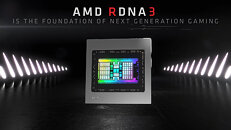Tuesday, August 17th 2021

DisplayPort 2.0 Could Land in Next-Generation AMD Radeon RDNA3 GPUs
AMD is slowly preparing to launch its next-generation of graphics cards based on the RDNA3 architecture, and it could bring some new connectivity options as well. Currently, the graphics cards we are using today use DisplayPort 1.4 connector for their DP output. However, the more advanced DisplayPort 2.0 could land in RDNA3 GPUs, bringing much-needed improvements to the video output system. What DP 2.0 brings to the table is an upgrade to an Ultra High Bit Rate individual lane speed of 20 GB/s, totaling 80 GB/s with four of those. The DP 2.0 capable system would be able to output a 10K uncompressed resolution at 60 Hz, or two 4K 144 Hz monitors at the same time. With compression, that would be extended much further. We have to wait and see what AMD does and if the next-generation RDNA3 brings this new DisplayPort standard to the masses.
Sources:
Freedesktop Patch, via VideoCardz

25 Comments on DisplayPort 2.0 Could Land in Next-Generation AMD Radeon RDNA3 GPUs
DP 2.1 or 2.2 will bring that up to 8k 240hz or so and we will be done on that front for displays, more will be possible but be pointless for consumers.
There are known problems with those. Not only the older dreaded power pin problem, but actually real certification and even with that some panels are really capricious.
vesa.org/press/vesa-publishes-displayport-2-0-video-standard-enabling-support-for-beyond-8k-resolutions-higher-refresh-rates-for-4k-hdr-and-virtual-reality-applications/
Displayport 2.0 specifications have been defined 2 years ago: it usually takes 18-24 months to produce a controller, it took a little longer because of covid.
I don't expect such a card to come out until at least 2028, and even then it will cost a fortune. Reasonable 8K gaming performance is just not possible yet, and I doubt it will be with RDNA3 or RTX 4000, either.
I don't understand people sometimes...
The difference between 1080p and 2160p on any size is DAY and NIGHT, the difference between 2160p and 4320p ON ANY SIZE will be day and night.
magnifying glasses exist to overcome the limits of your sight to decern tiny details/differences, once we are at 8k unless you get a REALLY big monitor and sit really close (Which...who would) its pointless to go for 16k, 32k 1024k....you wont be able to see a difference.
Just your guesses.
And no, my vision has no limits.
It's just like 144hz refresh rate is a billion times better than 60hz, but 240hz-360hz compared to 144hz, even though it's better, it's not that monumental.